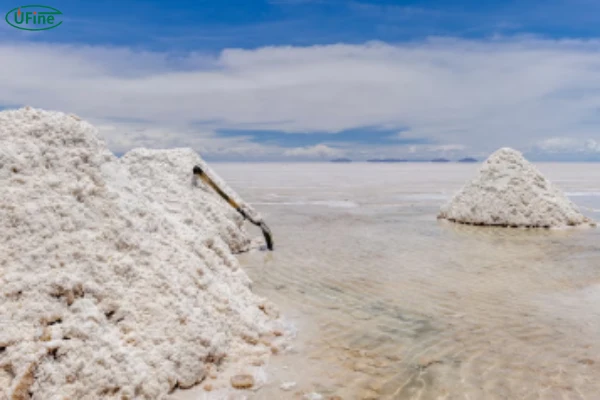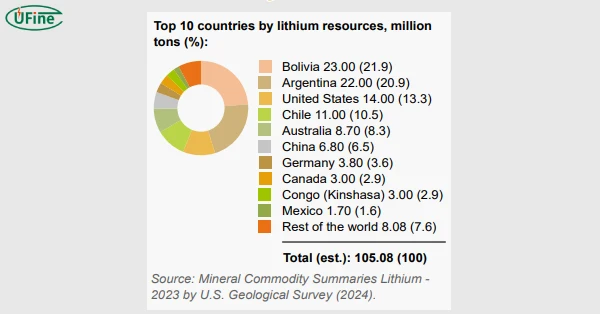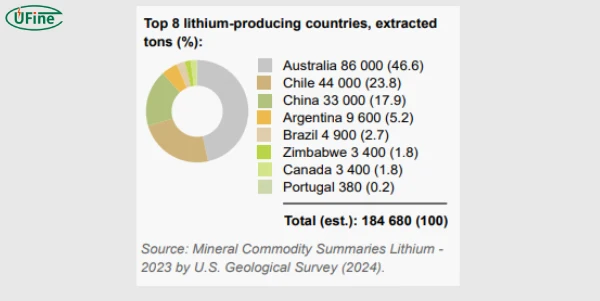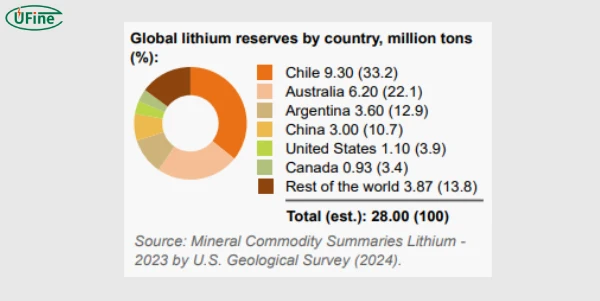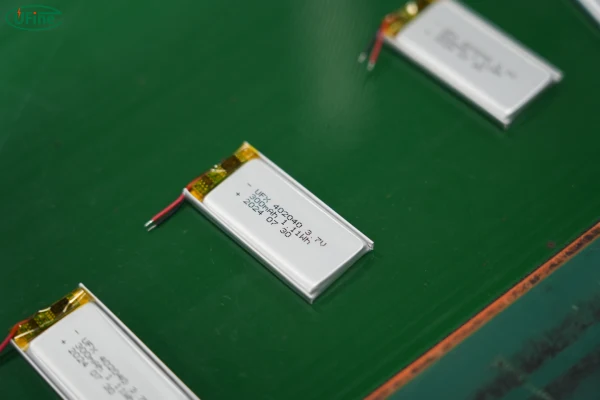Part 1. Overview of lithium
Lithium, the lightest and one of the most reactive metals, has become the backbone of modern energy solutions. Its high energy density and ability to store and release electrons make it the perfect material for batteries. Historically, lithium was considered an industrial additive, earning the nickname “MSG of industry” due to its versatility in ceramics, glass, and lubricants. However, the global push toward sustainability has turned lithium into a key driver of the renewable energy revolution.
As part of the rare metals category in the non-ferrous metals industry, lithium now plays a critical role in electric vehicles (EVs), renewable energy storage systems, and advanced technologies. Its demand continues to grow as the world shifts toward greener energy solutions.
Part 2. The lithium industry chain
The lithium industry is a multi-tiered chain comprising exploration, processing, and application. Let’s break it down:
Upstream: Lithium Extraction
Lithium is extracted from two primary sources:
- Salt Lake Brines: These are vast salt flats rich in lithium-containing brines, where lithium is separated through evaporation processes. The largest reserves are found in South America’s “Lithium Triangle” (Bolivia, Argentina, and Chile).
- Hard Rock Deposits: Spodumene, a lithium-rich mineral, is mined and processed into lithium concentrates. Australia leads the world in this type of extraction.
Midstream: Lithium Processing
Once extracted, raw lithium undergoes processing to create lithium salts such as lithium carbonate, lithium hydroxide, and lithium chloride. These are further refined to meet the high purity requirements for specific uses:
- Battery-grade lithium: Used in the production of cathodes for lithium-ion batteries.
- Industrial-grade lithium: Used in glass, ceramics, and lubricants.
Downstream: Applications of Lithium
Processed lithium finds its way into a wide array of industries, the most prominent being:
- Energy Storage: Lithium-ion batteries dominate EVs, grid energy storage, and portable electronics.
- Aerospace and Defense: Lightweight lithium alloys reduce aircraft weight, improving fuel efficiency.
- Medical: Lithium compounds are used in psychiatric treatments and other pharmaceutical applications.
Part 3. Global lithium resources

Lithium reserves are geographically concentrated, with significant resources in salt flats and hard rock deposits. According to the U.S. Geological Survey (USGS), global lithium reserves total approximately 89 million tons.
Key Resource-Holding Countries
- Bolivia: The leader in lithium reserves (21 million tons), particularly in the vast Uyuni Salt Flats.
- Argentina and Chile: Together with Bolivia, these countries form the “Lithium Triangle,” responsible for a significant portion of global production.
- Australia: A powerhouse in hard rock lithium mining, particularly spodumene.
- China: A major producer and innovator in lithium extraction technologies.
Part 4. Lithium reserves: how long will they last?
Based on the current global proven lithium reserves of about 128 million tons, as well as the current mining speed and demand, lithium resources are expected to be used for at least 500 years. Of course, this time is not absolute, it is affected by many factors, such as the improvement of mining technology, the discovery of new mineral deposits, and the recycling and reuse of lithium resources.
The reserves of lithium resources are affected by many factors:
- Discovering New Reserves: Ongoing exploration efforts continue to uncover new lithium deposits, potentially extending the lifespan of existing reserves.
- Technological Advancements: Improvements in extraction techniques and battery technology could increase the efficiency of lithium usage, prolonging the life of reserves.
- Increased Demand: The growing demand for lithium-ion batteries, particularly for electric vehicles and energy storage, could accelerate the depletion of reserves.
- Recycling: Advances in lithium-ion battery recycling could help recover and reuse lithium, mitigating the need for new mining.
Part 5. Where can lithium be used?
Lithium’s versatility has made it indispensable in many sectors:
-
Electric Vehicles (EVs)
Lithium-ion batteries are the heart of EVs, offering the energy density and performance needed for long-range vehicles. Tesla, BYD, and other automakers rely heavily on lithium batteries. -
Energy Storage Systems (ESS)
Lithium-ion batteries stabilize renewable energy grids and power residential and commercial storage units. -
Consumer Electronics
Smartphones, laptops, tablets, and wearable devices all use lithium-ion batteries due to their compact size and high energy capacity. -
Aerospace and Defense
Lithium alloys and batteries are used in satellites, drones, and advanced military systems for lightweight energy solutions. -
Medical Applications
Lithium compounds are effective in treating mental health disorders like bipolar disorder and are also used in diagnostic devices. -
Glass and Ceramics
Adding lithium improves strength, durability, and thermal shock resistance, making it essential in specialty glass products.
Part 6. How to use lithium to produce lithium batteries?
Creating lithium batteries involves several detailed steps:
1. Mining and Processing Lithium
Lithium is extracted from either brines or hard rock deposits and processed into lithium carbonate or lithium hydroxide.
2. Purification
The extracted lithium is refined to meet battery-grade purity standards, removing impurities that could affect performance.
3. Cathode and Anode Preparation
The purified lithium compound is used to produce cathode materials, such as lithium cobalt oxide or lithium iron phosphate. Graphite is typically used for the anode.
4. Cell Assembly
The cathode, anode, separator, and electrolyte (which also contains lithium salts) are assembled into a battery cell.
5. Testing and Integration
Each cell undergoes rigorous testing before being combined into modules and battery packs for EVs or energy storage systems.
Part 7. The future of lithium resources
Bolivia’s New Chapter
Bolivia, despite holding the largest lithium reserves, struggled with commercialization until 2023. A partnership with a Chinese consortium led by CATL marked a turning point, enabling industrial-scale lithium extraction and processing.
Global Supply Expansion
- Australia: Restarting operations at dormant mines and launching new projects.
- South America: Accelerated development of salt flats, supported by advanced Chinese extraction technologies.
- Africa: Rich in spodumene deposits, African lithium projects are rapidly advancing.
- China: Boosting domestic extraction efforts to secure supply chain stability.
Balancing Supply and Demand
While lithium demand continues to rise, production is beginning to catch up. A market once dominated by shortages is moving toward balance, although demand from EVs and energy storage will sustain its importance.
Part 8. Lithium’s impact on battery performance
Lithium plays a crucial role in the performance of lithium-ion batteries. Here’s how lithium contributes to battery performance:
1. Energy Density
Lithium ions are lightweight and highly mobile, allowing them to move easily between the anode and cathode of the battery during charging and discharging. This enables the battery to store a significant amount of energy in a compact and lightweight package.
2. Voltage
Lithium-ion batteries can deliver a higher voltage compared to other battery chemistries. This higher voltage translates to greater power output and longer battery life.
3. Cycle Life
Lithium-ion batteries exhibit excellent cycle life, meaning they can be charged and discharged numerous times without significant degradation in performance. This is due to the reversible nature of the electrochemical reactions involving lithium ions.
4. Fast Charging
Lithium-ion batteries can be charged relatively quickly, especially with advanced charging technologies. This is facilitated by the rapid movement of lithium ions within the battery.
5. Environmental Benefits
Lithium-ion batteries have lower environmental impact compared to some other battery types, as they do not contain toxic metals like lead or cadmium.
Challenges and Future Developments:
While lithium-ion batteries offer significant advantages, there are still challenges to be addressed:
- Battery Life: Lithium-ion batteries can degrade over time, leading to reduced capacity and performance. Researchers are working on improving battery materials and chemistries to extend battery life.
- Safety Concerns: Lithium-ion batteries can pose safety risks, such as thermal runaway, if not handled properly. Advancements in battery management systems and safer materials are being explored to mitigate these risks.
- Supply Chain and Environmental Impact: The mining and processing of lithium can have environmental and social impacts. Sustainable mining practices and recycling technologies are crucial to minimize these impacts.
Part 9. Conclusion
Lithium has become a cornerstone of the green revolution, fueling innovations in EVs, energy storage, and more. From its vast reserves in Bolivia to its transformation into high-tech batteries, lithium’s role in shaping the future of energy and technology is undeniable. As production scales and applications expand, lithium is set to remain a critical material for decades to come.
Related Tags:
More Articles

How to Choose the Best Floor Scrubber Battery for Commercial Cleaning?
Selecting the ideal floor scrubber battery ensures a long runtime, rapid charging, and minimal maintenance for efficient commercial cleaning operations.
Battery for Blower vs Battery for Leaf Vacuum: Which One Should You Choose?
Battery for blower vs leaf vacuum—learn the key differences in power, fit, and runtime to choose the right battery for your outdoor tool needs.
How to Choose the Right Battery for Blower?
Choosing the right blower battery? Consider voltage, capacity, chemistry & usage. This guide helps match the best battery for peak performance.
How to Choose the Best Insulated Battery Box for Lithium Batteries?
Choosing the Best Insulated Battery Box for Lithium Batteries? Discover key factors such as size, material, and safety for optimal protection and performance.
7 Critical Elements on a Lithium Battery Shipping Label
What must be on a lithium battery shipping label? Learn 7 key elements to ensure safety, legal compliance, and correct handling across all transport modes.
